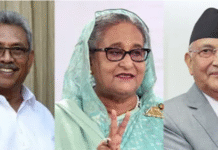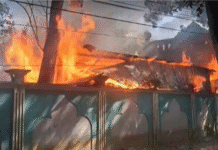
Two important Bangladesh-India meetings at the national level took place in the last month of 2020. The first of the two, a virtual summit of the two prime ministers held on December 17, was preceded by the grim news of the death of yet another Bangladeshi killed in BSF firing on the border. Although we are used to getting such sad news, the latest killing, coming as it did on the eve of the virtual summit, assumed an enhanced poignancy.
A week after that, another Bangladeshi was shot dead by the Indian BSF along the Mymensingh border while the director general of BGB was being welcomed in Guwahati on December 22, where he had gone to attend one of the half-yearly DG-level meetings of the heads of border forces. The top agenda point, as usual, was the issue of border killings. And one can assume that nothing could be more frustrating for the DG-BGB than to be greeted by the news of the killing. It was an irony and one can guess that those who generally dismiss these killings as unfortunate or as acts in self-defence, and describe the victims as miscreants, can apply the template explanation (which we shall deal later in this piece) to describe the circumstances of the death of the latest victim of BSF firing—the total number of which stands at around 48 in 2020. According to the commanding officer of the BGB battalion responsible for that area, “the incident might have happened when the man was attempting to go across the border”. This statement conveys much more than the 15 words the sentence is composed of. I shall dwell more on this subsequently.
Like a few other important issues of consequence to Bangladesh, it’s time for India to deliver on the oft-repeated and even more oft-broken assurances of zero killing on the border. The positive point—if killings ever can have a positive aspect—is that ours is no longer the most dangerous international border in the world that it was a decade ago, when the BSF came under the scrutiny of the Human Rights Watch which used the appellation “trigger happy” in respect of its members. Although it is true that fewer Bangladeshis are falling victim to the BSF bullets now, the figure of 48 victims is a statistic that cannot but provoke the shortest question in English vocabulary: WHY? When the level of mutual understanding at government level between the two countries has never been better, the WHY assumes even more pertinence. One of the assurances we are constantly given is that the BSF would no longer use lethal weapons, i.e. no metal bullets but rubber ones instead. We had been given to understand that rubber bullets don’t kill. Given the sad statistics mentioned above, either the BSF have not lived up to their assurances, or rubber bullets do kill.
It would appear that the border killings have been taken as a fait accompli. My view has been reinforced by comments emanating from both sides, issued after formal meetings at different levels of command of the two border forces, and after every killing of a Bangladeshi on the borders.
Let us take, for example, the BGB’s comment explaining the killing of a Bangladeshi on December 22, that “the incident might have happened when the man was attempting to go across the border”. The sentence conveys to me—and I’m sure to everyone with the littlest of comprehension—that the commanding officer was not entirely sure of the circumstances of the killing, and that the victim had not actually crossed the border. Thus the only rational conclusion is that he was shot dead inside Bangladesh territory. I believe this merits an answer.
One also notices a tendency of the BSF to paint everyone killed in their firing as criminals, and every act of firing as acts in self-defence. But that doesn’t wash either. One acts in self-defence after being attacked or anticipating an attack. One has not been offered any credible evidence by the BSF to validate their argument. Let me use the statement of the DG-BSF to counter his point. This is what he was quoted as saying at the end of the recently concluded DG-level meeting in Guwahati: “BSF personnel fire with non-lethal weapons only in self-defence when they are surrounded by large numbers of miscreants armed with ‘dah’ (cleaver-shaped knife), sticks, etc. and their lives are endangered.” So, if there are a large number of people surrounding them, how come only a single person is killed? What happens to the rest who are armed with knives threatening the safety of the well-armed BSF personnel? Was Zahid armed? (Zahid fell to BSF bullets on December 16 last year) Our foreign minister should seek answers to these questions instead of accepting such statements at face value.
India does not see these as killings—these are “deaths”, according to the Indian BSF commanders. As we had commented on this very issue nearly a decade ago, semantics cannot screen the reality nor can that bring the dead to life. It only adds to the agony of the victims, almost all of whom belong to the border areas. And whatever explanations, justifications, reasoning, or validations are offered for these killings, they cannot help prevent a negative mind-set developing in the minds of the people. Bangladesh-India border is not quite like other international borders. It is unique in many ways, and managing it requires much more than following slavishly the template orders and standard operating procedures (SOPs). I believe the border fence is the villain of the piece. Most of the Bangladeshis living in the border areas mistake the fence for the border and approach the fence without realising that it is actually approximately 137 metres inside the Indian territory, with certain exceptions. The border is “alive” and demands a more humane approach by the border guards. Let not the BSF commitment of zero border killing be, as a recent report in this paper so aptly headlined, a promise tangled up in barbed wire.
Brig Gen Shahedul Anam Khan, ndc, psc (Retd), is a former Associate Editor of The Daily Star.









